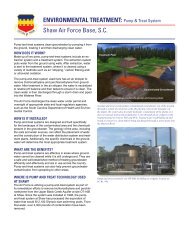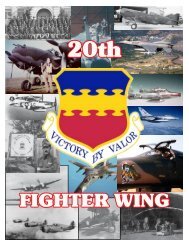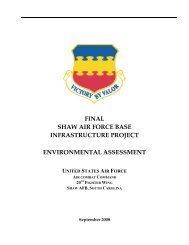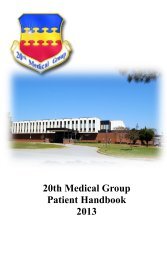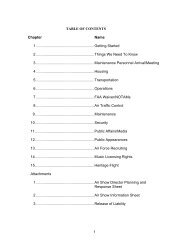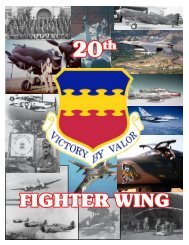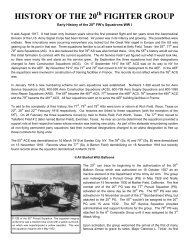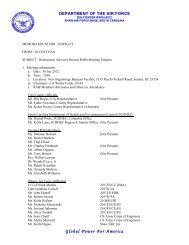20th Fighter Wing Guide to Preparing for the ORI
20th Fighter Wing Guide to Preparing for the ORI - Shaw Air Force ...
20th Fighter Wing Guide to Preparing for the ORI - Shaw Air Force ...
- No tags were found...
Create successful ePaper yourself
Turn your PDF publications into a flip-book with our unique Google optimized e-Paper software.
2009<br />
<strong>20th</strong> <strong>Fighter</strong> <strong>Wing</strong><br />
<strong>Guide</strong> <strong>to</strong> <strong>Preparing</strong> <strong>for</strong><br />
<strong>the</strong> <strong>ORI</strong><br />
What Every Airman Should Do <strong>to</strong> Prepare<br />
1<br />
<strong>20th</strong> FW<br />
Team Shaw<br />
4/14/2009
Why Did We Give You This <strong>Guide</strong><br />
To ensure you’re fully prepared <strong>for</strong> <strong>the</strong> <strong>ORI</strong>. Use <strong>the</strong> attached<br />
checklists as a guide <strong>to</strong> help you prepare. These checklists represent<br />
expertise <strong>the</strong> IG expects you <strong>to</strong> know during <strong>the</strong> <strong>ORI</strong>. These<br />
checklists do not replace your responsibility <strong>to</strong> read AFMAN 10-<br />
100, ―Airman’s Manual‖ or AFMAN 10-2602. If in<strong>for</strong>mation<br />
conflicts, published guidance supersedes <strong>the</strong>se checklists.<br />
Additionally, this guide provides essential in<strong>for</strong>mation individuals<br />
and small units/teams must accomplish prior <strong>to</strong> <strong>the</strong> <strong>ORI</strong>. Section<br />
one focuses on individual skills, section two focuses on<br />
standardization and section three covers general in<strong>for</strong>mation <strong>for</strong> <strong>the</strong><br />
<strong>ORI</strong>.<br />
At a minimum, here are <strong>the</strong> following things you need <strong>to</strong> do <strong>to</strong><br />
prepare <strong>for</strong> <strong>the</strong> <strong>ORI</strong>.<br />
1. Know your job cold – The <strong>ORI</strong> is nothing more than doing your job in a<br />
different uni<strong>for</strong>m—chemical gear! Doing your job is <strong>the</strong> single biggest<br />
fac<strong>to</strong>r <strong>to</strong>ward success in <strong>the</strong> <strong>ORI</strong>. It means per<strong>for</strong>ming your assigned<br />
tasks safely and by <strong>the</strong> book.<br />
2. Read – The <strong>ORI</strong> is an open book test. To pass with flying colors, you<br />
need <strong>to</strong> read <strong>the</strong> Airman’s Manual, AFI 90-201, AFMAN 10-2602, and<br />
Shaw AFB Base X Plan.<br />
3. Look at previous reports – Previous reports provide intel on <strong>the</strong> IG<br />
Team.<br />
4. Keep a positive attitude and show <strong>the</strong> IG just how good you are!<br />
2
Have you Read<br />
1. Airman’s Manual (AFMAN 10-100)<br />
2. AFI 90-201, ACC Sup<br />
3. AFMAN 10-2602<br />
4. Base X Plan<br />
3
Table of Contents<br />
SECTION 1 INDIVIDUAL <strong>ORI</strong> PREP ACTIONS……………………………………..5<br />
GENERAL PREPARATIONS………………………………………………………6<br />
ATTACK CHECKLIST – ACTIONS WHEN YOU HEAR ALARM CONDITIONS…...7<br />
STANDARDIZATION ATTACK WARNING SIGNS………………………………....9<br />
SABC CHECKLIST………………………………………………………………10<br />
ATNAA KIT CHECKLIST…………………………………………………..……11<br />
<strong>ORI</strong> UXOS……………………………………………………………………….12<br />
WHAT TO DO (OR NOT DO) WITH AN IG – KEYS TO SUCCESS………………......14<br />
20FW BE-NO’S – THERE WILL BE-NO………………………………………….15<br />
SECTION 2 STANDARDIZATION CHECKLISTS………………………………….…..17<br />
VEHICLE OPERATOR’S QUICK REFERENCE……………………………………..18<br />
VEHICLE SIMULATIONS………………………………………………………......19<br />
FACILITY MANAGER CHECKLIST………………………………………….……..20<br />
COVERING EQUIPMENT, VEHICLES, AND OTHER ASSETS…………………….....21<br />
VEHICLE EQUIPMENT HARDENING………………………………………….…...22<br />
INDIVIDUAL PROTECTION CHECKLIST…………………………………………...24<br />
PAR TEAM BRIEFING GUIDE…………………………………………………..... 26<br />
PAR TEAM CHECKLIST…………………………………………………………...27<br />
M-8 REPORTING GUIDE……………………………………………………….......31<br />
CONTAMINATED REMAINS CHECKLIST…………………………………………...32<br />
SECTION 3 OTHER IMPORTANT INFORMATION……………………………………..33<br />
COMPUTER NETWORK INCIDENT REPORTING CHECKLIST…………………….....34<br />
20TH FIGHTER WING CRITICAL INFORMATION LIST……………………………..36<br />
4
Section 1<br />
Individual <strong>ORI</strong> Prep Actions<br />
5
General Preparations<br />
Pre-Exercise/Inspection Preparations<br />
1. Inspect equipment <strong>to</strong> identify and resolve deficiencies and discrepancies (see<br />
attached IPE self inspection checklist)<br />
2. Complete mask-fit testing<br />
3. Complete mask leak test (Every 24 months)<br />
4. Acquire required combat spectacles / inserts<br />
5. Read/review Airman’s Manual<br />
6. Read AFMAN 10-2602<br />
7. Attend ATSO Training – Every ORE<br />
8. Attend ground rules brief – Every ORE<br />
During Exercise<br />
1. Park in designated parking area<br />
2. Leave cell phones, pagers, etc. outside play area<br />
3. Remove contacts, earrings, hair clips & wear combat spectacles/inserts<br />
4. Enter and exit TA from approved ECP<br />
5. Know shelter location and processing procedures<br />
Report <strong>to</strong> shelter in Alarm Yellow or when directed<br />
6. Know CCA location and processing procedures<br />
Report <strong>to</strong> CCA when directed by <strong>the</strong> UCC<br />
7. Report all activity <strong>to</strong> UCC or control center using<br />
S-A-L-U-T-E <strong>for</strong>mat<br />
8. Know and execute Transition Point procedures<br />
9. Always travel in pairs<br />
10. Practice OPSEC<br />
11. Obtain Chem Codes, Duress Words & Sign/Countersign<br />
Individual Knowledge – Expect you’ll be asked questions about <strong>the</strong>se areas<br />
1. Meaning of alarm signals (Green, Yellow, Red, Black)<br />
2. MOPP levels (0, 1, 2, 3, 4)<br />
3. What MOPP variations are & when authorized<br />
4. Purpose of M8 & M9<br />
5. How <strong>to</strong> place M8 & M9<br />
6. Purpose & use of M291 & M295<br />
7. How <strong>to</strong> mark and call in UXO’s<br />
8. S-A-L-U-T-E report <strong>for</strong>mat<br />
9. SABC procedures<br />
10. Actions required <strong>for</strong> all Alarm conditions<br />
11. Use of ATNAA injec<strong>to</strong>rs<br />
12. Contaminated areas and transition point procedures<br />
13. Actions related <strong>to</strong> computer virus and classified message incident<br />
14. Obtain UCC permission <strong>to</strong> transport deceased personnel EOC/ESF 8/11<br />
approval be<strong>for</strong>e transport<br />
OPSEC<br />
1. Know <strong>20th</strong> FW Critical In<strong>for</strong>mation List<br />
2. Answer phone call saying ―line-up,‖ complete phone call saying ―line-down‖<br />
6<br />
Complete
Attack Checklist – Actions When You Hear<br />
Alarm Conditions<br />
Action<br />
Complete<br />
Alarm Green - Attack is Not Probable<br />
1. Remain in protected areas until directed by chain of command<br />
If directed <strong>to</strong> per<strong>for</strong>m outside ops utilize as much overhead cover as possible<br />
and maximize use of contamination avoidance measures<br />
2. Don MOPP as directed<br />
Wear field gear and personal body armor as required and directed<br />
Remove contact lenses, earrings, hair clips, and spectacle inserts<br />
3. Maintain watch <strong>for</strong> covert attack indications<br />
Remain observant <strong>for</strong> signs of a covert or suspicious activity<br />
Report any activity <strong>to</strong> your UCC or control via S-A-L-U-T-E report<br />
4. Review evacuation plan, shelter location<br />
5. Review transition point procedures and post attack recovery operations<br />
procedures<br />
Procedures <strong>for</strong> moving from contaminated <strong>to</strong> uncontaminated zones<br />
6. Continuously re-evaluate protective actions<br />
Replenish expended material (e.g., IPE and nerve agent antidote)<br />
7. Conduct team drills & training <strong>to</strong> assure readiness <strong>for</strong> various attack responses<br />
Alarm Yellow - Attack is Probable in Less Than 30 Minutes. Attack expected. Focus on final<br />
protection and contamination avoidance. Reduce MOPP level only when directed<br />
1. Don MOPP as directed. Hydrate. Follow work rest cycles<br />
2. Per<strong>for</strong>m buddy checks<br />
3. Ensure all personnel in immediate area correct MOPP level & know current alarm<br />
4. Protect and cover assets<br />
5. Remain in shelter, go <strong>to</strong> shelter or seek protection with overhead cover<br />
Alarm Red - Attack by Air, Missile, or Ground Forces is Imminent or In Progress<br />
1. React <strong>to</strong> Alarm Red warning immediately<br />
Execute <strong>the</strong> most stringent Alarm Red protective actions in lieu of guidance<br />
2. Take cover<br />
If your location becomes <strong>to</strong>o dangerous, move <strong>to</strong> a safer location<br />
Assist injured personnel. Remain in current position & under cover until<br />
directed<br />
3. If in bunker, follow bunker checklists <strong>for</strong> survivability and accountability<br />
4. Keep away from exterior walls of <strong>the</strong> shelter<br />
Use desks & interior rooms <strong>to</strong> provide additional protection in unhardened<br />
facilities<br />
5. Use Buddy Checks <strong>to</strong> verify proper IPE wear<br />
6. Report attacks or enemy personnel movement <strong>to</strong> UCC or work center ASAP<br />
Armed individuals defend yourself under current ROE & coord actions<br />
w/o<strong>the</strong>rs in area<br />
7. Maintain accountability of your buddy<br />
7
8. Per<strong>for</strong>m self-aid and buddy care<br />
Report casualties<br />
Report observations or symp<strong>to</strong>ms of chem or bio <strong>to</strong> UCC or shelter mgt team<br />
Alarm Black - Attack is Over<br />
1. Continue <strong>to</strong> wear IPE according <strong>to</strong> MOPP declaration<br />
2. Remain under cover & check yourself/o<strong>the</strong>rs <strong>for</strong> evidence of contamination<br />
If contamination is found, complete immediate decon with M291 & M295<br />
decon kit; contact UCC if contaminated; report <strong>to</strong> CCA only when directed <strong>to</strong><br />
by UCC<br />
Per<strong>for</strong>m SABC as needed<br />
3. Be vigilant <strong>for</strong> UXO, casualties, contamination, and facility or equipment damage<br />
Report all positive findings <strong>to</strong> UCC or work center via S-A-L-U-T-E report<br />
Stay in a protected position with overhead cover unless you are in personal<br />
danger or must per<strong>for</strong>m rescue or assist casualties that cannot move<br />
<strong>the</strong>mselves <strong>to</strong> your position<br />
4. Know contaminated areas – execute transition point procedures<br />
5. Be aware of contaminated equipment, vehicles, buildings – execute appropriate<br />
procedures<br />
6. Clearly report UXO, casualties, building damage and contamination<br />
8
Standardized Attack Warning Signals<br />
9
SABC Checklist –<br />
Expected Response <strong>to</strong> SABC Situations<br />
Refer <strong>to</strong> Airmen’s Manual pg. 177<br />
Task/Action<br />
1. Conduct thorough & prompt post-attack searches <strong>to</strong> identify casualties<br />
2. Don/place protective masks immediately on casualty when CBRN conditions<br />
exist<br />
3. Act with sense of urgency<br />
4. Check <strong>for</strong> breathing<br />
5. Check <strong>for</strong> wounds—Entry & exit<br />
6. Identify different types of bleeding--Arterial/Veins/Capillary<br />
7. Use direct pressure with a dressing <strong>to</strong> s<strong>to</strong>p bleeding<br />
8. Know direct pressure, elevation, pressure points, <strong>to</strong>urniquet steps and<br />
hemostatic agent<br />
9. Use bandage <strong>to</strong> secure dressing <strong>to</strong> casualty<br />
10. Know how <strong>to</strong> apply a splint correctly<br />
11. Use proper litter technique <strong>for</strong> opening litter with <strong>the</strong> foot<br />
12. Use 2 litter straps<br />
13. Use a 4 man litter carry<br />
14. Person <strong>to</strong> <strong>the</strong> head and right of casualty is in charge of <strong>the</strong> litter team<br />
15. Transport casualty feet first<br />
16. Load casualty on<strong>to</strong> vehicle head first, so <strong>the</strong>y can be off loaded feet first<br />
17. Transport casualty <strong>to</strong> DMF or o<strong>the</strong>r designated area <strong>for</strong> medical care<br />
18. Prevent fur<strong>the</strong>r injury <strong>to</strong> casualty (e.g., protect injury site/put casualty in a<br />
bunker)<br />
19. Use an improvised SABC equipment as appropriate<br />
20. Use manual carries as required<br />
Completed<br />
10
ATNAA A Kit<br />
ATNAA Kit Checklist<br />
Task/Action<br />
1. Know symp<strong>to</strong>ms of nerve agent poisoning - Dimming vision,<br />
Sweating/Excessive sweating, Drooling Runny nose, Nausea,<br />
Vomiting/Diarrhea, Tightness in chest, Difficulty breathing, Involuntary<br />
urination, Involuntary defecation, Pinpoint pupils, Unconsciousness,<br />
Muscles twitching, Seizures<br />
2. Know when/how <strong>to</strong> use ATNAA<br />
3. Use ATNAA injec<strong>to</strong>r<br />
Check area <strong>for</strong> clear access upper outer thigh/but<strong>to</strong>cks<br />
Hold firm pressure until injec<strong>to</strong>r injects<br />
Hold <strong>for</strong> 10 seconds/bend needle and place on upper jacket<br />
4. Wait 10-15 minutes <strong>to</strong> see if symp<strong>to</strong>ms subside and Heart increases and<br />
mouth becomes dry (did member know?)<br />
5. Repeat with second ATNAA if symp<strong>to</strong>ms do not subside or increased heart<br />
rate and dry mouth does not occur<br />
6. If member is unconscious and muscles twitching<br />
Administer all ATNAA<br />
After all /ATNAA administer Diazepam<br />
7. Remove injec<strong>to</strong>r, bend needle on ground & attach <strong>to</strong> OG pocket<br />
Completed<br />
11
<strong>ORI</strong> UXOs<br />
Recognize, Record, Retreat, Report<br />
Report UXO <strong>to</strong> UCC:<br />
1. Location, cordon size, how UXO is marked, & distance between UXO and marker<br />
2. Class or shape (i.e. Foxtrot 1)<br />
3. UXO features<br />
4. UXO Condition (leaking? Intact? Broken?)<br />
5. O<strong>the</strong>r In<strong>for</strong>mation<br />
Completed<br />
12
13
What <strong>to</strong> do (or not <strong>to</strong>-do) with an IG - Keys <strong>to</strong><br />
Success<br />
Task/Action<br />
1. Military Appearance/Cus<strong>to</strong>ms and Courtesies<br />
Display outstanding military appearance, professionalism, and courtesy<br />
2. Communication skills<br />
Communicate effectively<br />
Maintain eye contact with <strong>the</strong> inspec<strong>to</strong>r<br />
When receiving inject or o<strong>the</strong>r instruction from <strong>the</strong> inspec<strong>to</strong>r clarify<br />
<strong>the</strong> tasks <strong>to</strong> per<strong>for</strong>m<br />
Review <strong>the</strong> applicable guidance; consult with co-workers and per<strong>for</strong>m<br />
task<br />
Solicit feedback from inspec<strong>to</strong>rs and channel in<strong>for</strong>mation up chain of<br />
command<br />
3. Housekeeping<br />
Keep duty section impeccably clean<br />
4. Safety<br />
Wear <strong>the</strong> proper safety equipment (i.e..eye protection, boots, gloves ,<br />
hearing protection)<br />
Duty section in compliance with AFOSH standards<br />
5. Security<br />
Maintain COMSEC/OPSEC<br />
Used End- of-Day Checklist<br />
Completed<br />
14
20FW BE-NO’s – There will BE-NO…<br />
…traveling alone – always travel with a wingman<br />
…Command and Control nodes (ICC, EOC, UCC/etc. ) using personal e-mail<br />
accounts<br />
…answering a phone call without saying ―line-up.‖<br />
…ending a phone call without saying ―line-down.‖<br />
…cell phones, IPODS, Personal lap<strong>to</strong>ps, Video Games, Harry Potter Novels,<br />
Latest Cosmopolitan etc. in <strong>the</strong> play area<br />
…improper MOPP Gear wear and use<br />
…lack of sense of urgency<br />
…conflicts w/inspec<strong>to</strong>rs<br />
…not respecting simulations<br />
…parking in <strong>the</strong> wrong place<br />
…sneaking in<strong>to</strong> Base X without processing TA<br />
…surfing <strong>the</strong> net on duty<br />
…reading anything o<strong>the</strong>r than AFMAN 10-100 or PME during dead time on<br />
shift<br />
15
16
Section 2<br />
Standardization Checklists<br />
17
Vehicle Opera<strong>to</strong>r’s Quick Reference<br />
1. Vehicles must be driven safely at all times<br />
a) Use spotters while backing<br />
b) Obey standard speed limits on and off flight line<br />
c) Chock all vehicles that do not have two <strong>for</strong>ms of brakes (i.e. trac<strong>to</strong>rs,<br />
wreckers, <strong>for</strong>klifts, buses etc.)<br />
d) Reflective belts must be worn during hours of darkness<br />
2. Prior <strong>to</strong> START EX, place SIM M8 paper on <strong>to</strong>p corners of vehicle windshield<br />
where liquid contamination will be sure <strong>to</strong> come in contact w/ paper during<br />
attacks<br />
3. Vehicle must be simulated <strong>to</strong>ned down/ blacked out. IAW Shaw Base X Plan,<br />
reflective surface covering will consist of a strip of masking tape affixed <strong>to</strong> all<br />
participating vehicle windshields<br />
4. Thoroughly check <strong>the</strong> vehicle <strong>for</strong> explosives and/or devices prior <strong>to</strong> using. Even if<br />
you are just changing out vehicles<br />
5. If vehicle is not in use accomplish <strong>the</strong> following:<br />
a) When possible, place <strong>the</strong> vehicle under cover or place steering wheel<br />
cover over <strong>the</strong> steering wheel<br />
b) Close all doors and roll up windows<br />
6. Opera<strong>to</strong>rs must have <strong>the</strong> following item on <strong>the</strong>ir person:<br />
a) GOV/CIV license<br />
b) AF Form 483 annotated with flight line competency (if applicable) and driving in<br />
MOPP 4 qualification<br />
c) Security line badge, if needed<br />
7. Accident Reporting Checklist (SF 91 and DD518) should be found with <strong>the</strong> AF1800 and<br />
waiver <strong>for</strong>m<br />
8. All vehicle damage/contamination inputs must be reported <strong>to</strong> UCC and Base X Vehicle<br />
Management<br />
9. Base X Phase II marking guidance can be found in <strong>the</strong> Shaw Base X Plan, Appendix 1 <strong>to</strong><br />
Annex D<br />
18
19
Facility Manager Checklists<br />
Refer <strong>to</strong> Annex Q in Base X Plan <strong>for</strong> diagram and picture of Facility<br />
Decon Station<br />
Facility Exterior<br />
1. Sandbags placed at every corner of facility/building/tent<br />
A. Surveyor’s tape/rope connected <strong>to</strong> sandbags (During ORE/ <strong>ORI</strong>)<br />
2. Staggered entryway in<strong>to</strong> facility outlined in surveyor’s tape/rope<br />
3. Contaminated waste collection container with lid:<br />
A. Cordoned off with surveyor’s tape/rope- 10 ft radius around container<br />
with 4 ft entrance on one side<br />
B. Cordoned off at least 10 feet away from staggered entryway<br />
C. Container lined with two layers of plastic (trash bags)<br />
D. Contaminated waste container sign affixed <strong>to</strong> container<br />
4. Decontamination area set-up with <strong>the</strong> following items:<br />
A. Two glove trough containers:<br />
One labeled w/masking tape ―Sim 5% bleach‖<br />
One labeled w/masking tape ―Water‖<br />
Both containers half filled with water<br />
B. One boot trough container w/lids:<br />
Labeled w/masking tape ―Sim 5% bleach‖<br />
Container half filled with water<br />
C. Facility Decontamination Station Procedures posted<br />
D. Facility Decontamination Station Log posted <strong>to</strong> track 400 uses and/or 48<br />
hours<br />
E. Two pieces of Sim M8 paper on table (opposite sides)<br />
F. Table covered with two pieces of plastic (held down with sandbags)<br />
G. Two pieces of Sim M8 paper on each layer of plastic (opposite sides)<br />
5. M8 stanchions set out<br />
Facility Interior<br />
1. UCC Leader set-up<br />
A. Current Copy of EOC quick reference guide<br />
B. Execute EOC Checklist #17 – Initial Beddown<br />
2. Facility moni<strong>to</strong>r’s area set-up with <strong>the</strong> following items:<br />
A. ATSO Facility Set-up Checklist<br />
B. Door Moni<strong>to</strong>r Checklist<br />
C. Building Accountability procedures<br />
D. Flashlights w/extra batteries<br />
E. Extra copies of PAR team map<br />
F. ATSO In<strong>for</strong>mation posted with <strong>the</strong> following items:<br />
Facility In<strong>for</strong>mation sheet<br />
Sign/Counter-sign, Duress Word & Chemical Code chart<br />
20<br />
Completed
Current PAR Map<br />
Current MOPP Level<br />
Current Alarm Conditions<br />
AFVA-10-2512, Mission Oriented Protective Postures (MOPP)<br />
AFVA-10-2511, USAF Standardized Attack Warning Signals<br />
Shaw AFB Critical In<strong>for</strong>mation List<br />
G. Self Aid Buddy Care Kit location and Casualty Litter location<br />
H. PAR Team (primary and alternate) identified/posted<br />
I. COMPUSEC Posters Posted<br />
J. Network Incident Reporting Aid displayed/posted near computer<br />
K. stations Bomb Threat Reporting Aid displayed/posted near phones<br />
Covering Equipment, Vehicles and O<strong>the</strong>r<br />
Assets<br />
Obtain Barrier Material<br />
1. Use water repellant plastic sheeting, canvas, tarpaulins, or specialized<br />
CBRN covers <strong>for</strong> barrier material<br />
2. Inspect all barrier material prior <strong>to</strong> use. Check <strong>for</strong> holes, rips, tears, etc<br />
3. Use at least two layers of cover so <strong>the</strong> <strong>to</strong>p cover, along with any<br />
contamination, can be easily removed, safely discarded, and replaced<br />
4. When placing M8, always use at least 2 pieces of M8 paper horizontally &<br />
only on surfaces free of debris/liquid (use M8 Sim Annex Q of Base X Plan)<br />
Cover <strong>the</strong> Asset<br />
1. Affix at least 2 pieces of M8 paper on item <strong>to</strong> be covered<br />
A. Annotate M8 with time/date it was placed (M8 should not have<br />
multiple time/dates written on it)<br />
B. This provides indication whe<strong>the</strong>r contamination has made it<br />
through barrier material and on<strong>to</strong> asset<br />
2. Place a layer of barrier material over <strong>the</strong> asset<br />
3. Affix at least 2 pieces of M8 paper on this and on each additional layer<br />
of barrier material<br />
4. Use a separa<strong>to</strong>r device <strong>to</strong> create a buffer space between barrier material<br />
layers<br />
A. Separa<strong>to</strong>r device can be dunnage, wooden pallet, sandbags, etc<br />
B. If only one barrier material layer is available <strong>for</strong> use, place<br />
separa<strong>to</strong>r between asset and barrier material<br />
5. Place second sheet of barrier material over <strong>the</strong> asset and properly affix<br />
M8 paper <strong>to</strong> it<br />
6. Ensure outermost layer has M8 paper properly affixed <strong>to</strong> it<br />
Secure Barrier Material<br />
1. Use sandbags <strong>to</strong> secure barrier material<br />
2. Roll or tuck excess barrier material inwards <strong>to</strong>wards <strong>the</strong> asset, secure<br />
with sandbags (make sure sandbags are inside <strong>the</strong> covering material)<br />
3.<br />
21<br />
Completed<br />
Completed
4. Sandbags must not be exposed<br />
5. Contact <strong>the</strong> UCC with location of asset and that it is covered<br />
Removing Contaminated Barrier Material<br />
1. Remove and fold contaminated barrier material in a manner <strong>to</strong><br />
encapsulate it’s contaminated surface<br />
2. Double bag <strong>the</strong> barrier material and place in established contaminated<br />
waste disposal points<br />
A. If contamination penetrates outer layer, separa<strong>to</strong>r device must<br />
be treated as contaminated waste<br />
3. If <strong>the</strong> unit contaminated waste container becomes full, unit will<br />
transport contaminated material <strong>to</strong> <strong>the</strong> zone contaminated waste<br />
collection point and notify UCC<br />
4. For more in<strong>for</strong>mation, see SAFB Contaminated Waste Disposal Plan<br />
Vehicle/Equipment Hardening<br />
Vehicles/Equipment Hardening- refer <strong>to</strong> Annex Q in Base X Plan <strong>for</strong> diagram<br />
1. All vehicles/equipment simulated protected by <strong>the</strong> following:<br />
A. Surveyor’s tape/rope connected <strong>to</strong> sandbags<br />
B. Tape connected <strong>to</strong> sandbags<br />
2. Vehicle doors do not extend beyond surveyor’s tape/rope (when opened)<br />
3. Vehicle/equipment does not extend beyond surveyors tape/rope<br />
Personnel Bunkers<br />
1. Sandbags placed at corners and entryway of bunkers<br />
A. Surveyor’s tape/rope connected <strong>to</strong> sandbags<br />
The bunkers can only hold a max of 20 personnel<br />
More than 20 personnel require additional bunker <strong>to</strong> be built<br />
B. All bunker dimensions are 15’x 15’<br />
C. The bunker’s entrance is at least wide enough <strong>for</strong> litter—4 ft<br />
Trans-Attack<br />
1. If missile, aircraft or unknown (Mortar) attack in your Zone, <strong>the</strong>n follow #3<br />
2. below If known OPFOR ground attack in your Zone, <strong>the</strong>n follow #4 below<br />
3. Procedures <strong>to</strong> assume <strong>the</strong> appropriate MOPP level<br />
C. If in MOPP 0 be<strong>for</strong>e <strong>the</strong> attack, remain in MOPP 0 w/helmet on<br />
D. If in MOPP 2 be<strong>for</strong>e <strong>the</strong> attack, dress <strong>to</strong> MOPP 4 w/helmet on<br />
E. All personnel stay low <strong>to</strong> <strong>the</strong> ground and use any available cover<br />
F. Moni<strong>to</strong>r Communications via TBMCS, giant voice, telephone, radio, etc<br />
4. Sniper/disturbance or suicide bomber<br />
A. All personnel take cover w/helmet on<br />
B. Stay low <strong>to</strong> <strong>the</strong> ground and use any available cover<br />
C. Moni<strong>to</strong>r Communications via TBMCS, giant voice, telephone, radio, etc<br />
5. Lock facility doors- as directed by EOC or FPCON instructions<br />
Completed<br />
22
Post-Attack Actions<br />
1. Alarm Black Initial Release: Begin personnel accountability and internal<br />
facility sweeps<br />
2. Release PAR Teams when Alarm Black Limited Release is called<br />
3. Moni<strong>to</strong>r status of PAR Teams while routes are ran<br />
4. In <strong>the</strong> event you lose communications with <strong>the</strong> primary PAR Team,<br />
release your alternate PAR Team<br />
5. Report all PAR Team findings/status <strong>to</strong> EOC/TBMCS while routes are<br />
being ran and upon completion of route<br />
6. Keep your ATSO In<strong>for</strong>mation Center updated<br />
A. Moni<strong>to</strong>r Communications via TBMCS, giant voice, telephone,<br />
7. Ensure radio, all personnel etc entering <strong>the</strong> facility/tent use <strong>the</strong> sign/counter-sign<br />
(or <strong>the</strong> chem code if in MOPP 4)<br />
8. After first chemical attack, ensure all personnel entering facility use <strong>the</strong><br />
facility decontamination station prior <strong>to</strong> entering facility (MOPP 4 – Full<br />
Decon, MOPP 2 – Boots only)<br />
NOTE: DO NOT ALLOW PERSONNEL INTO FACILITY IF CONTAMINATED.<br />
They should stay outside in <strong>the</strong> bunker and wait <strong>for</strong> notification <strong>to</strong> proceed<br />
<strong>to</strong> CCA. UCC must contact EOC <strong>to</strong> receive permission <strong>to</strong> send<br />
contaminated personnel <strong>to</strong> CCA<br />
Standard 20 Personnel Bunker<br />
23
Individual Protection Checklist – For Donning,<br />
Inspection and Response <strong>to</strong> Attacks<br />
Items in bold italics can result in a “KIA or WIA”<br />
if not done correctly – Cover applicable steps based<br />
on type of IPE (JSLIST or BDO)<br />
IPE Checklist Frequency Completed<br />
1. Helmet marked with rank, first and last name, and USAF on front Pre-Exercise<br />
and back of helmet<br />
2. Jacket marked with rank, first and last name, and USAF over Pre-Exercise<br />
wearer’s right breast (see AFMAN 10-100, pg 27)<br />
3. Jacket marked "Sim IBA" over wearer’s left breast, if no IBA/flak Pre-Exercise<br />
vest is available <strong>to</strong> wear (ACC Standard SIM)<br />
4. Simulated M9 placed correctly on suit (see AFMAN 10-100, pg Pre-Exercise<br />
37)<br />
5. Filter canister intact (not hollowed out) Pre-Exercise<br />
6. DD Form 1574 shows current mask inspection date and due date Pre-Exercise<br />
one week out, mask must have an inspection date within 7 days of<br />
<strong>the</strong> exercise<br />
7. DD Form 1574 shows required in<strong>for</strong>mation in accordance with <strong>the</strong> Pre-Exercise<br />
Airman’s Manual p. 212, <strong>to</strong> include date leak tested (leak test is<br />
good <strong>for</strong> 2 years)<br />
8. Mask fit test accomplished, carried in mask carrier and wearing Pre-Exercise<br />
correct size <strong>for</strong> which <strong>the</strong>y were tested<br />
9. Member is aware of proper cleaning procedures Pre-exercise<br />
10. Mask is in serviceable condition with no missing parts Pre-exercise<br />
11. Individual has Airman’s Manual in <strong>the</strong>ir possession Pre-exercise<br />
12. Individual has canteen filled with water Pre-Exercise<br />
13. Helmet secured Donning<br />
14. “Fogged up” mask?, check <strong>for</strong> hood trapped between outsert Donning<br />
lens and main lens or twisted mask straps. Still fogging? - check<br />
inside mask <strong>for</strong> missing discs. Females w/long hair –let it hang<br />
freely and tuck in jacket<br />
15. Mask carrier properly worn and closed Donning<br />
16. Mask clean and free of residue that may cause malfunction or Donning<br />
produce health issues<br />
17. Individual can demonstrate properly drinking from canteen with Donning<br />
mask on<br />
18. BDO Trousers:<br />
19. Fly snaps and zipper fastened Donning<br />
24
20. Side pull straps adjusted Donning<br />
21. Leg zippers secured, hook and pile flaps secured and ankle strings Donning<br />
tied<br />
22. BDO coat:<br />
23. Front zipper, snaps and sleeves secured Donning<br />
24. Coat rear snaps secured <strong>to</strong> trousers. Donning<br />
25. Waist cord tight drawn up and tied in a bow tie. Donning<br />
26. Protective hood:<br />
27. Outlet valve covered Donning<br />
28. Under arm straps fastened Donning<br />
29. Adjustable neck strap secured under hook and pile fasteners <strong>for</strong> Donning<br />
underarm straps<br />
30. JSLIST Trousers:<br />
31. Fly snaps and zipper fastened Donning<br />
32. Suspenders over shoulders Donning<br />
33. Waistband hook and pile fasteners secured <strong>to</strong> a snug fit Donning<br />
34. Hook and pile fasteners on ankles secured Donning<br />
35. JSLIST Coat:<br />
36. Front zipper secured; hook and pile fasteners secured on jacket Donning<br />
front and wrists<br />
37. Elastic retention cord pulled through legs and snapped in place Donning<br />
38. Coat retention cord tied in<strong>to</strong> a bow tie Donning<br />
39. Hood positioned properly with hook and pile fasteners secured Donning<br />
40. Hood barrel locks snapped <strong>to</strong>ge<strong>the</strong>r / draw strings tightened<br />
41. Overboots:<br />
42. Fully fastened Donning<br />
43. Worn underneath trousers Donning<br />
44. Gloves:<br />
45. Glove insert gauntlet under duty uni<strong>for</strong>m Donning<br />
46. Glove gauntlet under BDO/JSLIST coat sleeves Donning<br />
25
PAR Team Briefing <strong>Guide</strong><br />
Unit Post Attack Reconnaissance (PAR) teams are a vital part of <strong>the</strong> <strong>Wing</strong>’s response <strong>to</strong><br />
attacks. PAR teams provide <strong>the</strong> commander a rapid means of locating casualties, fires,<br />
contamination, unexploded ordnance (UXO) / Improvised Explosive Devices (IEDs)<br />
identifying and marking hazards, and determining status of damage assessment <strong>to</strong><br />
facilities and /or equipment in unit areas. The Commander and staff use in<strong>for</strong>mation<br />
collected during PAR <strong>to</strong> determine <strong>the</strong> need <strong>for</strong> and priority of conducting recovery<br />
operations, such as Split MOPP implementation , firefighting, casualty treatment,<br />
UXO/IED safeing, airfield damage repair, and facility res<strong>to</strong>ration<br />
1. Unit PAR teams are directed through <strong>the</strong>ir Unit Control Centers (UCCs). Team(s)<br />
will consist of a minimum of 2 personnel each and will have alternate team(s)<br />
identified and trained. Alternate PAR team(s) will assume PAR duties if Primary<br />
team(s) become incapacitated or unavailable.<br />
2. PAR teams must have all equipment listed in <strong>the</strong> PAR team equipment inven<strong>to</strong>ry in PAR<br />
team checklist.<br />
3. Prior <strong>to</strong> attacks, <strong>the</strong> teams are responsible <strong>for</strong> executing unit plans <strong>for</strong> prepositioning<br />
SIM M8 paper, dispersing and maintaining security of unit assets,<br />
expedient hardening measures, and placing and maintaining <strong>the</strong> serviceability of<br />
contamination avoidance covers.<br />
4. After attacks, PAR teams will ensure <strong>the</strong> entrance is clear and proceed around <strong>the</strong> facility<br />
on a pre-established route ensuring <strong>the</strong>y are not walking side by side. Upon discovery of<br />
UXOs/IEDs, contamination, casualties, and/or damage <strong>the</strong> PAR team will immediately<br />
report <strong>the</strong> in<strong>for</strong>mation <strong>to</strong> <strong>the</strong>ir UCC. Upon completion of <strong>the</strong>ir route <strong>the</strong> team will mark<br />
off all hazards. The PAR team will report back <strong>to</strong> <strong>the</strong> facility if additional assistance is<br />
required <strong>for</strong> casualties, UXOs/IEDs, etc.<br />
5. The PAR team members must understand and know how <strong>to</strong> do <strong>the</strong> following:<br />
• Complete <strong>the</strong> PAR checks as promptly and safely as possible.<br />
• Conduct self-aid/buddy care procedures.<br />
• Depart <strong>the</strong> facility when directed by UCC<br />
• Use extreme caution and watch <strong>for</strong> UXOs/IEDs in entranceways<br />
• Report findings <strong>to</strong> <strong>the</strong> UCC<br />
• Use Facility Decontamination station prior <strong>to</strong> re-entering <strong>the</strong> building<br />
NOTE: Only use bright, white light when checking M-8 paper. Do not use colored lenses.<br />
26
PAR Team Checklist<br />
Introduction<br />
NOTE: The primary objective of <strong>the</strong> PAR Team is <strong>to</strong> confirm or deny:<br />
The existence of CBRN contamination<br />
The presence of UXOs/IEDs<br />
The presence of opposing <strong>for</strong>ces<br />
The presence of fires, casualties, etc.<br />
Damage <strong>to</strong> mission essential facilities and/or assets<br />
The secondary objective of <strong>the</strong> PAR Team is <strong>to</strong> identify:<br />
Render SABC <strong>to</strong> injured<br />
The type of Chemical Biological Radioactive and Nuclear (CBRN)<br />
contamination<br />
The type of UXOs/IEDs<br />
Damage <strong>to</strong> vehicles, equipment, roads/taxiway/ramp, buildings, etc.<br />
ORGANIZE, TRAIN, AND EQUIP<br />
1 Primary and Alternate members must have completed PAR Training<br />
2 Read AFMAN 10-2602, pages 213-233<br />
3 Assemble and inven<strong>to</strong>ry PAR Kit and First Aid Kit (see below)<br />
4 Train primary and alternate members on facility specific routes<br />
5 Become familiar with PAR Routes <strong>for</strong> buildings adjacent <strong>to</strong> facility (buddy<br />
building). Ensure you have a copy of <strong>the</strong>ir PAR map.<br />
BEFORE ANY ATTACK – AT BEGINNING OF EACH SHIFT<br />
1 Assemble and inspect PAR team equipment<br />
2 Survey area of responsibility<br />
3 Identify primary and alternate teams and routes<br />
4<br />
Run routes every 2 hours <strong>to</strong> check <strong>for</strong> status of equipment (detection, dispersal<br />
and covering), alteration in terrain/ route, possibility of covert attack or IED<br />
placement.<br />
5 Annotate map with key in<strong>for</strong>mation and provide a copy <strong>to</strong> <strong>the</strong>ir UCC<br />
6 Identify facility power, gas, HVAC and fuel cu<strong>to</strong>ffs<br />
7 Pre-position SIM M8 paper<br />
8 Identify expedient firefighting assets<br />
9 Identify location and inspect first-aid kits<br />
10 Identify blackout actions<br />
11 Review UXO identification chart<br />
12 Identify assets / Implement contamination avoidance actions (i.e. covering of<br />
assets, facility decontamination stations setup, etc.)<br />
13 Assume appropriate MOPP level as directed<br />
14 Check that all team members have donned gear correctly and completely<br />
according <strong>to</strong> MOPP level<br />
Check team members <strong>to</strong> ensure everything is correctly taped, snapped,<br />
zipped, tied, annotated, etc.<br />
Study PAR Team route and designate who will follow each route if<br />
<strong>the</strong>re are multiple routes<br />
Study route of buddy building<br />
Review expected procedures<br />
Completed<br />
27
15 At <strong>the</strong> start of each shift, check that <strong>the</strong> PAR Kit has all required items (see<br />
attachment 1, PAR Team Equipment Inven<strong>to</strong>ry). Resupply as necessary.<br />
Confirm radios communicate clearly with UCC<br />
16 Notify <strong>the</strong> UCC of your team’s status, i.e.:<br />
All members equipped ready <strong>to</strong> go<br />
Team not ready <strong>to</strong> go because…<br />
DURING ANY ATTACK<br />
1 Take cover, preferably inside a building AND near <strong>the</strong> entrance<br />
AFTER ANY ATTACK<br />
Expected procedures:<br />
If you hear ―ALARM RED – MOPP 4,‖ be prepared <strong>to</strong> wait about 20 minutes<br />
be<strong>for</strong>e being released <strong>to</strong> check route<br />
If you hear ―ALARM RED – MOPP 2,‖ be prepared <strong>to</strong> be released 5 minutes<br />
after <strong>the</strong> explosions s<strong>to</strong>p<br />
1 When ―INITIAL RELEASE‖ call issued, take accountability of personnel and<br />
begin internal sweep of building <strong>for</strong> damage and casualties<br />
2 Assemble near <strong>the</strong> entry of your building with all team members/equipment<br />
but wait <strong>for</strong> UCC/Facility Manager <strong>to</strong> relay ―LIMITED RELEASE‖ call<br />
3 If you are waiting <strong>for</strong> ―LIMITED RELEASE,‖<br />
Check team members again – if <strong>the</strong>re is time – <strong>to</strong> ensure everything is<br />
correctly taped, snapped, zipped, tied, annotated, etc.<br />
4 When ―LIMITED RELEASE‖ call issued, open door cautiously and check ―5<br />
and 25‖ – i.e., look around <strong>the</strong> first 5 feet, <strong>the</strong>n around next 25 feet; if you see:<br />
Opposing Forces: Take cover; call in utilizing S-A-L-U-T-E <strong>for</strong>mat<br />
UXOs/IEDs within 5 feet:<br />
o Close door<br />
o Report findings <strong>to</strong> UCC<br />
o Exit through ano<strong>the</strong>r door<br />
UXOs/IEDs within 25 feet:<br />
Go around <strong>the</strong> UXO<br />
Move appropriate distance from UXO be<strong>for</strong>e reporting it <strong>to</strong> UCC<br />
via radio<br />
Minimum 25 feet <strong>for</strong> handled radio<br />
Minimum 100 feet <strong>for</strong> vehicle radio<br />
Keep moving<br />
START your PAR routes:<br />
One person looks <strong>to</strong> <strong>the</strong> right while <strong>the</strong> o<strong>the</strong>r looks <strong>to</strong> <strong>the</strong> left. Keep<br />
team staggered; do not walk right next <strong>to</strong> each o<strong>the</strong>r.<br />
Scan <strong>the</strong> ground <strong>for</strong> UXOs/IEDs; scan <strong>the</strong> trees and roof-<strong>to</strong>ps <strong>for</strong><br />
items; if you see anything:<br />
Move appropriate distance away from suspected UXO/IED be<strong>for</strong>e using<br />
radio<br />
Call UCC on radio <strong>to</strong> report finding; if you recognize <strong>the</strong> type, report<br />
that<br />
Keep moving – don’t s<strong>to</strong>p <strong>to</strong> cordon it now (at night place a light stick <strong>to</strong><br />
assist in finding <strong>the</strong> hazard when you return <strong>to</strong> cordon it after your route<br />
is complete.)<br />
Completed<br />
28
Check M8 paper on all stanchions, equipment and vehicles; look on<br />
glass and in low areas <strong>for</strong> droplets; if you see anything:<br />
Report findings <strong>to</strong> UCC:<br />
Exact location of stanchion<br />
Color and density of contamination using <strong>the</strong> M8 Reporting <strong>Guide</strong> (see<br />
attachment 2)<br />
Keep moving - don’t s<strong>to</strong>p <strong>to</strong> mark it now (at night place a light stick <strong>to</strong><br />
assist in finding <strong>the</strong> hazard when you return <strong>to</strong> mark it after your route<br />
is complete.)<br />
Look <strong>for</strong> environmental indica<strong>to</strong>rs – dead wildlife, discolored foliage -<br />
report findings <strong>to</strong> UCC and keep moving<br />
Look <strong>for</strong> biological sprayers - report finding <strong>to</strong> UCC and keep moving<br />
Check M9 paper on each o<strong>the</strong>r <strong>for</strong> contamination frequently; if<br />
positive per<strong>for</strong>m immediate decon and report contamination <strong>to</strong> UCC<br />
If casualties are found:<br />
Do only essential SABC <strong>to</strong> s<strong>to</strong>p bleeding<br />
Call in in<strong>for</strong>mation about injured and request assistance<br />
IF YOU DON’T FIND ANYTHING – report negative M8 results <strong>to</strong><br />
UCC every 3 rd stanchion <strong>to</strong> confirm you’re still outside, instead of after<br />
each negative stanchion<br />
AFTER finishing your route:<br />
Notify UCC you’ve completed your route<br />
Check <strong>to</strong> see if o<strong>the</strong>r team has completed <strong>the</strong>ir route; assist if necessary<br />
Go back <strong>to</strong> assist with SABC <strong>for</strong> injured<br />
Go back <strong>to</strong> specifically identify and cordon off UXOs/IEDs IAW Base<br />
X Plan<br />
Go back <strong>to</strong> mark contaminated vehicles, equipment and assets IAW Base X<br />
Plan<br />
BEFORE re-entering <strong>the</strong> building:<br />
Follow posted Facility Decontamination Station procedures<br />
Report findings <strong>to</strong> UCC<br />
AS REQUIRED<br />
5 Conduct expedient firefighting<br />
6 Take injured <strong>to</strong> <strong>the</strong> casualty collection point<br />
7 Report enemy activity (S-A-L-U-T-E <strong>for</strong>mat)<br />
8 Report enemy casualties and abandoned weapons<br />
9 Survey vehicles and equipment <strong>for</strong> damage<br />
10 Maintain contact with <strong>the</strong> UCC or EOC<br />
11 Request UCC or EOC assistance<br />
12 Advise UCC or EOC on ability <strong>to</strong> conduct mission<br />
14 Practice contamination avoidance<br />
15 Conduct immediate decontamination<br />
PAR Team Equipment Inven<strong>to</strong>ry Frequency Completed<br />
Flashlight (high quality, >5000 candlepower) with Batteries<br />
2 ea<br />
Chemical Light Stick 20<br />
Surveyors Tape<br />
4 rolls<br />
Wire flags or ground stakes<br />
12 ea<br />
29
M8 Paper (simulated)<br />
M9 Paper (simulated)<br />
Magnifying Glass<br />
Standard contaminated asset sign<br />
Standard UXO marking sign<br />
Indelible Marking pen<br />
Pencils<br />
Masking Tape (1-2‖ Wide) and Indelible Marking Pen<br />
Map or Diagram of PAR Routes and Responsibility Area<br />
Radio on Unit Network with Spare Batteries<br />
IFAC or equivalent<br />
50 sheets<br />
2 rolls<br />
1 ea<br />
12 ea<br />
12 ea<br />
2 ea<br />
2ea<br />
2 Rolls/2 Pens<br />
1 ea<br />
1 ea<br />
1 ea<br />
30
31
Contaminated Remains Checklist<br />
Contaminated Remains Checklist Frequency Completed<br />
1. <strong>Wing</strong>man of deceased/contaminated Airman will contact <strong>the</strong>ir squadron<br />
UCC.<br />
2. UCC will contact EOC/ESF representative.<br />
3. ESF (host squadron) will coordinate with DMF ESF representative and<br />
ICC <strong>for</strong> approval <strong>to</strong> transport contaminated remains.<br />
4. Best route <strong>for</strong> transporting of remains will be identified by EOC.<br />
5. ESF (squadron) will in<strong>for</strong>m UCC of best route.<br />
6. UCC will notify <strong>Wing</strong>men of best route.<br />
7. <strong>Wing</strong>man passes identification in<strong>for</strong>mation <strong>to</strong> UCC, and UCC will notify<br />
ESF representative (DMF/ESF representative will ask <strong>for</strong> specific data on<br />
individual if available)<br />
8. Four man litter carry with litter straps will be used (2 straps all <strong>the</strong> time<br />
<strong>for</strong> safety- no walking dead in Base X). The Airman at <strong>the</strong> right of <strong>the</strong><br />
victim’s head is in charge of lift commands. Ref: Airman’s Manual<br />
9. Transport remains in covered vehicle <strong>to</strong> DMF if available.<br />
10. Arrive outside DMF entrance perimeter with remains. Coordinate with<br />
DMF through your UCC in advance <strong>to</strong> ensure <strong>the</strong>y know you are arriving<br />
with contaminated remains.<br />
11. Once you have dropped off <strong>the</strong> remains at <strong>the</strong> DMF, in<strong>for</strong>m your UCC<br />
of task completion.<br />
12. Decontaminate your vehicle and any items you may have come in<br />
contact with while transporting <strong>the</strong> contaminated remains.<br />
32
Section 3<br />
O<strong>the</strong>r Important In<strong>for</strong>mation<br />
Info you should know (OPSEC, Critical<br />
In<strong>for</strong>mation List, etc.)<br />
33
Computer Network Incident Reporting Checklist<br />
34
35
<strong>20th</strong> <strong>Fighter</strong> <strong>Wing</strong> Critical In<strong>for</strong>mation List<br />
1. Decrease/shortfalls in combat capability/readiness of <strong>the</strong> 20 FW<br />
2. Passwords-NIPRNET, SIPRNET, TBMCS, GCCS<br />
3. Mission aircraft data that includes routes, orbits, altitudes, call signs,<br />
frequencies, or times in operation <strong>to</strong> include wing flying schedule<br />
4. O-Plans 20 FW personnel have responsibility <strong>for</strong> or are actively<br />
working<br />
5. Airlift in<strong>for</strong>mation indicating employment dates/times, locations,<br />
number/types of aircraft<br />
6. Deployment, Mobilization, Employment, and TDY details<br />
7. Command, control, and communications capabilities and procedures<br />
8. Reaction times <strong>to</strong> worldwide crisis situations<br />
9. Weapon systems capabilities, limitations, effectiveness, and expected<br />
uses<br />
10. Constraints placed on opera<strong>to</strong>rs or operations; limiting fac<strong>to</strong>rs affecting<br />
operations<br />
11. Positions of equipment, supplies, or manpower in preparation <strong>for</strong><br />
operations<br />
12. In<strong>for</strong>mation on items such as flight plans, maps, cold/hot wea<strong>the</strong>r gear,<br />
or admin items that could indicate <strong>the</strong> location of an operation<br />
13. Data revealing time schedules of an operation<br />
14. Employment capabilities at Collocated Operating Bases (COBs), Main<br />
Operating Bases (MOBs), Follow-on Locations (FOLs), and dispersed<br />
locations<br />
36
15. VIP movements when traveling in anticipation of an exercise or<br />
contingency<br />
16. Aircraft employment capabilities and tactics<br />
17. Personnel status reports (locations, type, number)<br />
18. Sortie generation mission planning in<strong>for</strong>mation revealing specific<br />
mission in<strong>for</strong>mation, including: Time over Target (TOT), Target<br />
locations, mission frequencies, laser codes, Identification Friend or Foe<br />
(IFF) codes, number and type of aircraft <strong>for</strong> a mission<br />
19. Tasking of 20 FW and o<strong>the</strong>r ACC organizations and <strong>the</strong>ir deployment<br />
locations under contingency/war plans<br />
20. DEFCON announcement <strong>for</strong> US <strong>for</strong>ces within a <strong>the</strong>ater and meaning of<br />
such announcements; Association of real world with exercise terms<br />
21. Aircraft conversion/modification schedules<br />
22. Relocation or activation of alternate command centers<br />
23. Results of local and HHQ exercise, evaluations, inspections and staff<br />
assisted visits<br />
24. Status of Programmed Maintenance (PDM) schedule and its impact on<br />
day-<strong>to</strong>-day capabilities and reaction <strong>to</strong> contingency tasking<br />
25. Recall Rosters and key personnel<br />
26. Increase in requests <strong>for</strong> wea<strong>the</strong>r data <strong>for</strong> a specific operational area<br />
27. Medical immunization requirements<br />
28. Significant changes in manpower strengths and work schedules in<br />
preparations <strong>for</strong> operations that would indicate time schedule of<br />
operation<br />
29. In<strong>for</strong>mation relating <strong>to</strong> Operation Noble Eagle (ONE) alert tasking<br />
30. Discussion of future unit’s capabilities being planned <strong>for</strong> Shaw AFB<br />
including Site Action Task Force (SATAF) results<br />
37
38



